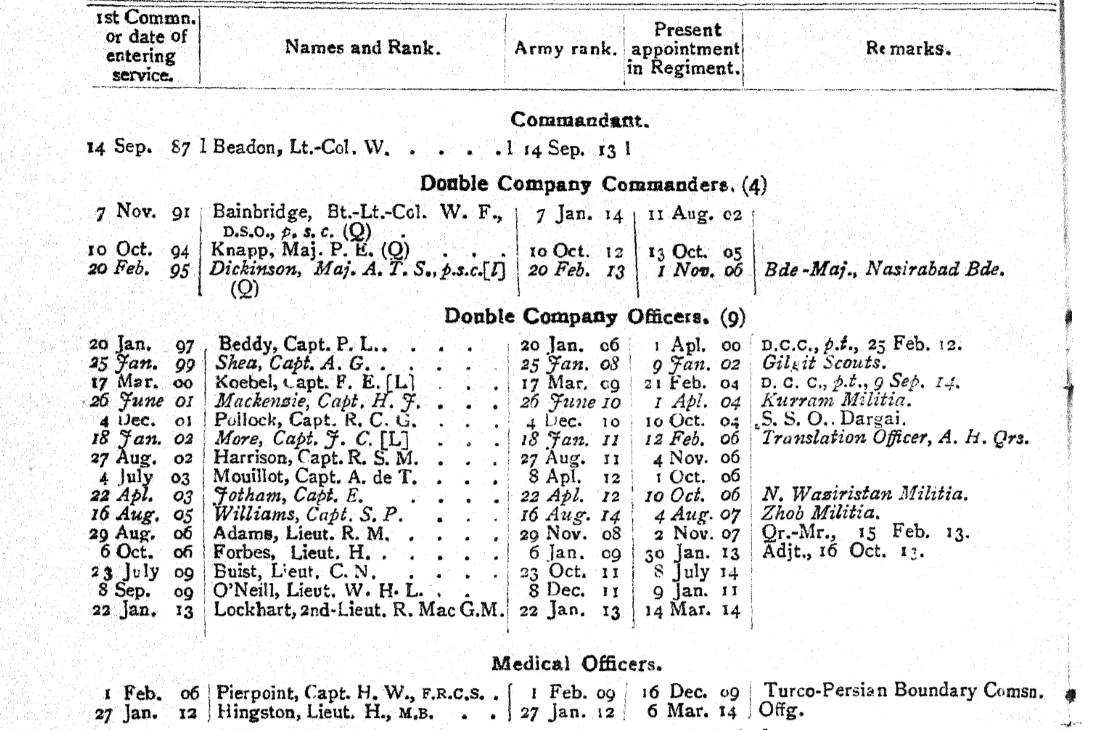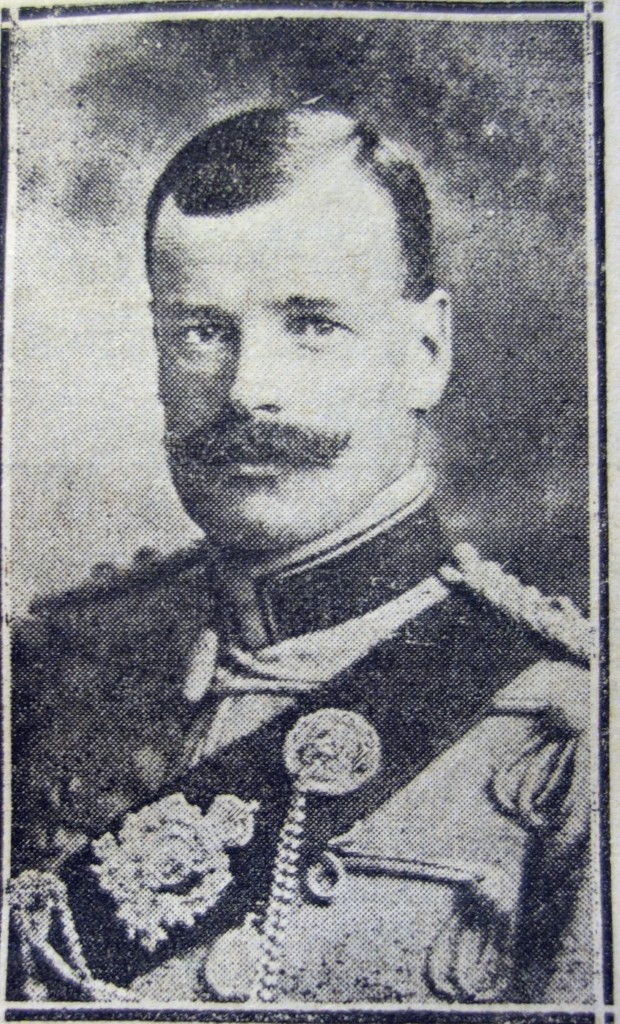This article on the 51st Sikhs (Frontier Force) aims to help you research either the Regiment or a soldier who served with it during the First World War. I have a series of guides to help you research soldiers who served in the Indian Army during the First World War. The links below will take you to the guides:
The 51st Sikhs (Frontier Force) in the First World War
Lineage: Raised by Captain J. S. Hodgson at Hoshiarpur in 1846-47 as the 1st Regiment of Infantry of the Frontier Brigade. In 1847 it became the 1st Regiment of Sikh Local Infantry and then the 1st Regiment of Sikh Infantry in 1857. In 1865 it became the 1st Regiment of Sikh Infantry Punjab Frontier Force and then the 1st Sikh Infantry in 1901. In 1903 it became the 51st Sikhs (Frontier Force) and the 1st Battalion 12th Frontier Force Regiment in 1922.
Class Composition in 1914: 4 Companies of Sikhs, 1 Company of Dogras, 2 Companies of Pathans and 1 Company of Punjabi Muslims. 1919: 2 Companies of Sikhs, 1/2 a Company of Dogras, 1 Company of Pathans and 1/2 a Company of Punjabi Muslims.
Location in July 1914: The 51st Sikhs was stationed at Dargai (Khyber Pakhtunkhwa, Pakistan) having arrived from Peshawar (Khyber Pakhtunkhwa, Pakistan) on 19th March 1914. A detachment was stationed at Chakdara (Khyber Pakhtunkhwa, Pakistan).
The 51st Sikhs (Frontier Force) was stationed at Dargai on the North West Frontier when the First World War began in August 1914. The Regiment was inspected by Major-General F. Campbell Commanding Kohat Brigade the same year who reported:
Personnel very good. Officers and Indian officers are good leaders. Signalling very satisfactory. Interior economy good and due economy is practised with regard to deductions for clothing. Discipline and health good. There is a falling off in individual average at musketry, not in my opinion altogether due to worn barrels.
The low proportion of men exercised in field practices is due to absence at brigade training with 1st Division and to recent rearmament. Fire direction and fire discipline are good and machine guns are tactically well handled. Reconnaissance work very satisfactory. A handy battalion in the field of whose fighting value I have a high opinion.
Fit for active service.
Confidential review reports on Indian Army units for 1913-1914: IOR/L/MIL/7/17023
The 51st Sikhs (Frontier Force) left India at Karachi on board the Hired Transport Conconada on 20 November 1914. The Regiment arrived at Suez, Egypt on 2 December and disembarked on 4 and 5 December. The Regiment remained in Egypt guarding the Suez Canal as part of the 28th Infantry Brigade, 10th (Indian) Division until it left for Mesopotamia (Iraq) on 20 November 1915. The extract below was taken from the October 1914 Indian Army List and recorded the British officers serving with the Regiment. The Indian Army List is a great resource to use to research both British and Indian officers and I have written a guide to help you with its jargon: Indian Army Abbreviations and Acronyms.

Captain Augustus De Thierry Mouillot had served with the 51st Sikhs (Frontier Force) since October 1906 and was described by his commanding officer as, ”A capable, tactful and reliable officer, with an exceptional knowledge of interior economy”. He was mortally wounded in January 1916 in Mesopotamia, dying on 15 January 1916 aged 33.
The 51st Sikhs (Frontier Force) remained in Mesopotamia until December 1917 when the Regiment moved to Egypt. The Regiment continued to serve as part of the 28th Indian Infantry Brigade, 7th (Meerut) Division for the remainder of the war. The 51st Sikhs (Frontier Force) remained in the Middle East until 1920 when the Regiment returned to India. In 1922, the 51st Sikhs (Frontier Force) was redesignated as the 1st Battalion 12th Frontier Force Regiment.
War Diaries of the 51st Sikhs (Frontier Force)
There are three war diaries for the 51st Sikhs (Frontier Force) but only the war diary covering its service in Mesopotamia has been digitized. To download this war diary for a small fee click on the second blue link below which will take you to the National Archives’ website. The other war diaries can only be viewed at the National Archives. I have copies of all the war diaries and have transcribed some entries below.
- Date: 01 October 1914 – 31 December 1915
- 28th Indian Infantry Brigade, 10th Indian Division, Canal Zone
- Reference: WO 95/4421
- Notes: A good war diary but very little happened while the Regiment was in Egypt.
- Date: 01 January 1916 – 30 December 1917
- 28th Indian Infantry Brigade, 7th (Meerut) Division
- Reference: WO 95/5140/5
- Notes: There are detailed entries for when the Regiment when it is in action but a lot of the entries cover multiple dates. Unfortunately, there are no appendices. However, this is still a good war diary. There is a list of British and Indian officers who sailed for Egypt with the Regiment in December 1917.
- Date: 01 January 1918 – 31 March 1920
- 28th Indian Infantry Brigade, 7th (Meerut) Division, Egyptian Expeditionary Force
- Reference: WO 95/4715
- Notes: An average war diary which doesn’t contain the level of detail that is often found for this period. For example, January and February 1918 are written on a single page (though entries become more frequent and detailed afterwards). British officers appear throughout and from April 1919, the war diary is typed.
Further Sources for the 51st Sikhs (Frontier Force)
If you are researching British or Indian officers who served with the 51st Sikhs (Frontier Force) then the Indian Army List can be consulted. A good resource for the 51st Sikhs (Frontier Force) is its confidential reports which are held at the British Library: Confidential Reports on Regiments etc. These reports also contain the annual reports of the British officers serving with the Regiment. However, when the 51st Sikhs (Frontier Force) was serving abroad only its Depot and the British officers serving with it were reported on.
Extracts from War Diaries of the 51st Sikhs (Frontier Force)
01 October 1914 – 31 December 1915, Canal Zone, WO 95/4421
03 February 1915 – Ismailia Ferry Post – Enemy found to be entrenching 1 mile East of Pot. Enemy were shelled by our guns and replied, several shells exploding in the post. Intermittent shelling continued all day. Casualties Nil. Enemy estimated at 1 battalion.
11 February 1915 – Ismailia Ferry Post – 51 Sikhs (Frontier Force) Less 1 Company proceeded on a reconnaissance to a point about 7 miles East of Bench Mark Post. Two camps temporarily occupied by enemy were visited. Old clothing, boots and kerosene oil tins littered the ground. No war material found with exception of 20 rounds ammunition and 2 rounds with painted wooden end in place of bullet. Returned same day.
11 March 1914 – 11.30 am – El Ferdan – Headquarters, Right Wing and Machine Gun Section 51st Sikhs (Frontier Force) embarked on tug and proceeded on Canal to Ismailia. 2 platoons of Machine Gun Mules marched to Ismailia by West bank having crossed canal by ferry. Ferry was impossible to work after this, owing to raging dust storm which blew the ferry aground.
27 December 1915 – 11.15 pm- Ali Al Gharbi – Enemy estimated strength 50 sniped camp for 10 minutes. No casualties. Enemy withdrew.
29 December 1915 – 9.45 pm – Ali Al Gharbi – Enemy estimated strength 50 attacked group and were driven off. One sepoy slightly wounded. Enemy’s casualties unknown.
01 January 1918 – 31 March 1920, Egyptian Expeditionary Force, WO 95/4715
29 – 30 April 1918 – Night – Forward Area – The work on Strong Point No.1 and the wiring of it was completed. It was noticed that the noise of hammering in the stakes could be heard a mile away, and that the wiring was a very slow business with inexperienced labour.
24 June 1919 – Urfa – It was notified that Chamouli village 8 miles south of Urfa was burning and on reports being received from villagers that this was the work of the Siyara tribe, one L.A.M.B. Car (Major Burrows) and one platoon in lorries (Lieutenant Clarke) was despatched to the village which was cleared of looters, who were harassed by M.G. and Lewis gun fire. Urfa was reached at 18.30 hours.

